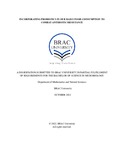| dc.description.abstract | An increase in antibiotic resistance throughout the globe threatens the survival of these lifesaving
drugs (ABR). One of the most pressing global health issues is antibiotic resistance, which
develops when bacteria or fungi acquire resistance mechanisms that make them vulnerable to
treatment with the most used antimicrobials. Animals reared for human consumption are
well-recognized as large reservoirs of antibiotic-resistant bacteria, and antibiotics used in food
and agriculture have contributed to the present worldwide ABR issue. Exploring alternative
probiotics is one of the many treatment options with promising effects. In the present study
several mechanisms by which probiotics inhibit the growth of pathogenic bacteria have been
described. These include probiotics' ability to alter the gut microbiota's composition, adhere to
the mucosa and epithelium on favorable terms, strengthen the gut epithelial barrier, and modulate
the host immune system. Some of the most widely eaten foods daily are poultry, fish, dairy, fruit,
and vegetable items. In this study it was also found that many important antibiotics such as
rifampin, cotrimoxazole, beta-lactams, spectinomycin, oxytetracycline, streptomycin, and many
more are used during production to promote growth, maximize yield, and reduce disease risk of
animals and plants; however, this practice increases the likelihood of the emergence and spread
of microbial resistance in those settings and posses a threat to the safety of the foods produced as
a result (due to antimicrobial residues). Estimates show that more than 60% of all antibiotics
made are used in the chicken industry. To reduce the overuse of antibiotics, this review paper
explores the potential function of probiotics, and how they operate to reduce infection for
example modification of microbial population, competitive adhesion to the epithelial receptor,
production of a specific substance, and so on, how they affect growth performance and
immunological response, such as systemic immunological response, local immunological
response and how they might be incorporated into the production of poultry, dairy, aquaculture
sector, fruits, and vegetables | en_US |

